Tag: Main Street Report

Mark your calendars! Experian and Oxford Economics will present key findings in the latest Main Street Report for Q3 2022 during the Quarterly Business Credit Review. Ryan Sweet, Oxford’s U.S. Chief Economist will share his take on Experian’s most recent small business credit data and a macroeconomic outlook for the coming quarter. Brodie Oldham, Experian’s V.P. of Commercial Data Science, will cover commercial credit trends. Our Presenters Brodie Oldham, V.P. Commercial Data ScienceExperian Ryan Sweet, U.S. Chief EconomistOxford Economics Q3 2022 Main Street Report The Q3 2022 Experian/Oxford Economics Main Street report will release at the end of November. If you are not already subscribed to thought leadership updates, be sure to sign up for updates on our Commercial Insights Hub. Event Details Date: Tuesday, December 6th, 2022Time: 10:00 a.m. (Pacific), 1:00 p.m. (Eastern) Why you should attend: Leading Experts on Commercial and Macro-Economic TrendsCredit insights and trends on 30+ Million active businessesAsk our panel questions in real-timeIndustry Hot Topics Covered (Inclusive of Business Owner and Small Business Data)Commercial Insights you cannot get anywhere elsePeer Insights with Interactive Polls (Participate)Discover and understand small business trends to make informed decisionsActionable takeaways based on recent credit performance Save My Seat
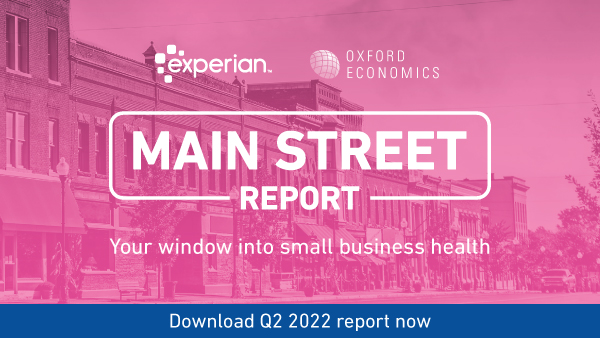
Experian and Oxford Economics have just released the Q2 Main Street Report. it offers a unique view of credit performance on millions of small businesses.

Mark your calendars! Experian and Oxford Economics will present key findings in the latest Main Street Report for Q2 2022 during the Quarterly Business Credit Review for Q2 2022. Kathy Bostjancic, Oxford's U.S. Chief Economist will share her take on Experian's most recent small business credit data and a macroeconomic outlook for the coming quarter. Brodie Oldham, Experian's V.P. of Commercial Data Science, will cover commercial credit trends. Q2 2022 Main Street Report The Q2 2022 Experian/Oxford Economics Main Street report is expected to release on August 23rd. If you are not already subscribed to thought leadership updates, be sure to sign up for updates on our Commercial Insights Hub. Mark Your Calendar Quarterly Business Credit Review Webinar Date: Wednesday, September 7th, 2022 Time: 10:00 a.m. (Pacific), 1:00 p.m. (Eastern) Why you should attend: Leading Experts on Commercial and Macro-Economic Trends Credit insights and trends on 30+ Million active businesses Ask our panel questions in real-time Industry Hot Topics Covered (Inclusive of Business Owner and Small Business Data) Commercial Insights you cannot get anywhere else Peer Insights with Interactive Polls (Participate) Discover and understand small business trends to make informed decisions Actionable takeaways based on recent credit performance Register To Attend
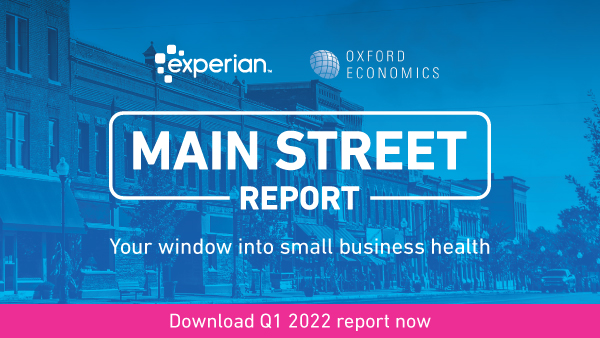
Experian and Oxford Economics have just released the Q1 2022 Main Street report, a window into the credit performance of small businesses complete with macroeconomic analysis. Highlights: The US economy contracted in Q1 for the first time since the pandemic-driven recession ended, but the domestic economy showed resilience in the face of Omicron, lingering supply constraints, and high inflation. Delinquency rates rose across the term periods; the 90+ days past due (DPD) climbed to 0.9 percent. Looking ahead, intensifying headwinds from more aggressive Fed tightening and tighter financial conditions will slow activity this year without stalling it. Download Q1 2022 Report Watch the Quarterly Business Credit Review Webinar Hear the experts from Experian and the lead economist from Oxford Economics unpack the latest Main Street Report. Watch the Quarterly Business Credit Review
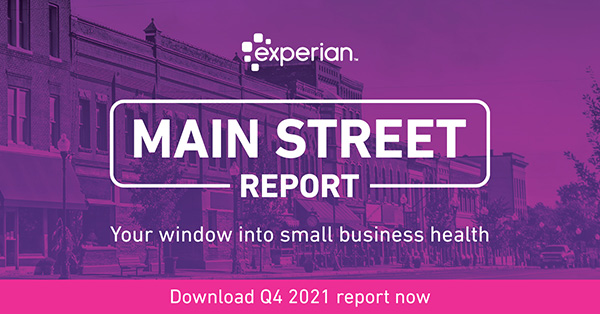
Experian Business Information Services has just released the Q4 2021 Main Street Report. In addition to the Omicron surge, which significantly impacted labor and consumer engagement, an inflationary surge, the most significant increase since 1982, coupled with supply-and-demand imbalances, weighed heavily on US small businesses, making a notable impact on consumer sentiment. While workers were getting raises in a tight job market, rapid price increases eroded consumers’ earning power. Average wage earnings went up by 4.0% in Q4 ’21 vs. the previous year, yet a 7.5% increase in inflation results in a net decline in real earnings. Workers’ money is not going as far as it used to. Download the latest report to get the full detail on Q4 2021 small business credit performance. Download Q4 2021 Report Join us for the Q4 Quarterly Business Credit Review We will be going in-depth on the Q4 business credit trends in our upcoming Quarterly Business Credit Review. We look forward to sharing the latest small business trends with you. Register for Webinar
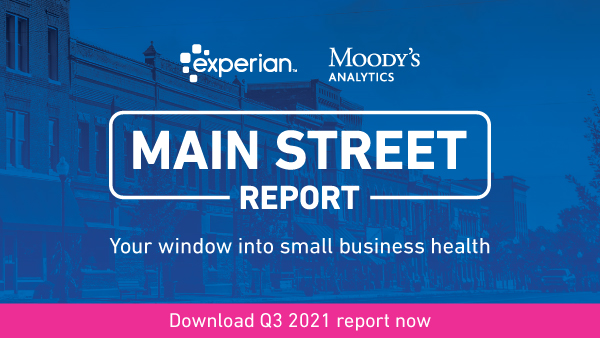
Experian and Moody's Analytics have just released the Q3 2021 Main Street Report. The report brings deep insight into the overall financial well-being of the small-business landscape and offers commentary on business credit trends and what they mean for lenders and small businesses. Labor shortages, wage pressure, and supply chain issues challenge small businesses Small business credit performance was mixed in the third quarter as businesses dealt with the COVID-19 Delta variant. Early-stage delinquency rates rose modestly while late state delinquency and bankruptcy rates fell decisively. With daily COVID cases falling, demand for goods and services should rise in coming quarters. Downside risks are concentrated on the supply side with businesses struggling to hire workers and dealing with supply chain stress. Early-stage delinquency rates rose in the third quarter with servicers reporting that 1.27% of small business credit balances were 31-90 days past due. While higher than the second quarter’s 1.19% rate, performance was only slightly worse than a year ago and significantly better than the pandemic high of 1.66%. Perhaps more notable was the sharp drop in late-stage delinquency, with 1.92% of balances reported as being more than 91 days past due. Supply chain issues are impacting both the availability and price of key inputs. Nowhere is this more apparent than in the semiconductor industry, where bottlenecks have shut down the manufacture of entire carlines. If you would like to get the full analysis of the data behind the latest Main Street Report, watch our Quarterly Business Credit Review webinar. Just scan the code or go to the short link and remember to download your copy of the latest report. Download Latest Report

Q2 2021 Main Street Report Highlights Experian and Moody's Analytics have just released the Q2 2021 Main Street Report. The report brings deep insight into the overall financial well-being of the small-business landscape and offers commentary on business credit trends and what they mean for lenders and small businesses. Here are a few highlights: Price increases and supply chain issues persist The labor shortage is driving wage growth in some industries GDP grew at 6.5 percent As some industries struggle to contain price increases and to survive in a post-pandemic world, others are thriving on the back of economic reopenings driving consumption. Reopenings and pent-up demand for services are pushing up economic growth and powering a robust economic recovery. Moderately delinquent small business credit, defined as 31-90 days past due (DPD), moved down in the second quarter to 1.19 percent. But severe delinquency moved higher in the second quarter to 2.35 percent. After a long period of decline, this upward movement in severe delinquency rates is the largest in the post-recession period. Rising costs is becoming a factor among small businesses as they service their credit obligations. In the most recent NFIB survey, 39 percent of respondents indicated they were raising wages. If we break this down, we can see that wages are rising at double-digit rates in industries, such as leisure and hospitality. And this could spell trouble on the horizon in some sectors, as employers fight to control expenses. Real GDP grew at an annualized rate of 6.5 percent in the second quarter, led by consumption. The rapid rebound from Covid-driven shutdowns sustained the rapid economic growth of the second quarter as stimulus continued and vaccination rates increased. Join us for a deep dive If you would like to get the full analysis of the data behind the latest Main Street Report, watch our Quarterly Business Credit Review webinar. Just scan the code or go to the short link and remember to download your copy of the latest report. Download Q2 Report
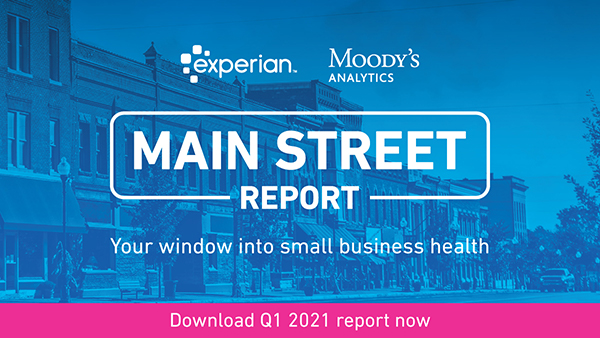
Experian and Moody's Analytics have just released the Q1 2021 Main Street Report. The report brings deep insight into the overall financial well-being of the small-business landscape and offers commentary on business credit trends and what they mean for lenders and small businesses. Small business credit performance hedged down slightly in Q1. But, pent-up savings, massive fiscal support, and the winding down of the Covid-19 pandemic will be driving forces for the economy and small businesses going forward in a post-pandemic recovery. Small businesses with fewer than 40 employees added 277,000 jobs in the first quarter, and by the end of 2021 the economy is slated to add nearly 5 million jobs as businesses reopen. After a PPP-induced decline in delinquency, the 31-90 days past due rate ticked up to 1.28 percent in the first quarter, from 1.21 percent in the fourth quarter, down from 1.61 percent one year ago. Despite a narrative that inflation is rapidly developing, small business owners seem unconcerned. The most recent NFIB survey of most important problems places inflation worries in single-digit territory. If you would like to get the full analysis of the data behind the latest Main Street Report, watch our Quarterly Business Credit Review webinar. Just scan the code or go to the short link and remember to download your copy of the latest report.
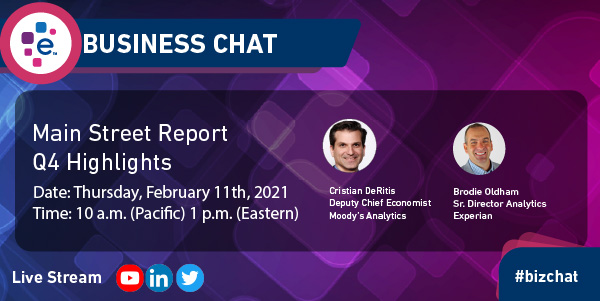
Main Street Report Q4 Highlights - Business Chat In this post we include a transcript from our February 11th Business Chat about the highlights in the most recent Main Street Report for Q4, 2020. We were joined by Cristian DeRitis, Deputy Chief Economist from Moody's Analytics, and Brodie Oldham, Senior Director of Analytics for Experian. [Gary]: Welcome to Business Chat. We're going to be talking about small business credit today—small business credit trends for Q4 with the release of the Experian Moody's Analytics Main Street Report. We've got the Deputy Chief Economist of Moody's Analytics, Christian DeRitis with us. Good morning, Christian. [Cristian]: Hi, good morning [Gary]: Good morning. [Gary]: And joining Christian is Brodie Oldham. He's a Senior Director of Analytics here at Experian. [Brodie]: Good morning. [Gary]: So glad you guys could join us today. So we're going to be taking a, look at the the highlights from the Experian Moody's Analytics Main Street Report just released. The report had three real standout items for me - the increase in hiring during Q4 that would be normally be expected. Delinquency rates declining to 1.21% and taxes as a main concern. We're showing that small businesses did add employees in Q4. It looks like those jobs appear to be funded primarily through credit. And businesses did keep the outstanding balances in check in Q4 with that moderate delinquency edging down to 1.21%, this time last year, it was around 1.60%. So, you know, there some good things there in the report, it seems kind of counter-intuitive, you know, when you read the headlines, but one of the things that also is starting to kind of resurge as a concern among business owners are taxes related to maybe a new administration and having things taking a different direction in terms of taxation. S. The thing that is probably on the minds of most small business owners and the nation really would be stimulus and getting some help for business owners. Biden has proposed a $1.9 trillion relief package. So Christian, I wanted to get your thoughts on the package, and if you could maybe cover some of the high points on it and what your thoughts are. [Cristian]: Yeah, sure. So they, you know, the $1.9 trillion package is an extension, if you will, of the cares act that we had last year or two, $2.4 trillion package, plus the additional stimulus that was passed at the end of December, really the purpose of those packages to my mind, it was largely preservation, right? We had households, small businesses that were really struggling under the weight of the pandemic and the associated closures. And so that assistance was really the lifeline to keep household finances in intact to some degree and to, and to preserve small businesses. Right? Last thing we wanted is to have millions of businesses failing. And then even when we get to the recovery stage, we don't have any, any of that, uh, that foundation to build off of the next, stimulus here. The 1.9 trillion that's been proposed, I think this package or some version of it is really intended to be stimulative to go to the next level where we have the vaccines kicking in the economy is recovering. You have consumers of being a little bit more positive and hopeful of the future here. And this package to me, is really designed to jumpstart some of the activity to ensure that we build some momentum and keep going in particular for small businesses. We have extension of the PPP program. That's the Paycheck Protection Program, this time around monies allocated are designed to be much more focused on the truly smallest businesses, many of which have been struggling and have few other options when it comes to credit. And so, I view that certainly as a positive as we, again, look forward to the future here, in terms of consumers coming back in leisure hospitality spending, coming back as people start to feel more comfortable after the vaccination efforts take hold. And so this, I, I do believe that this stimulus is certainly beneficial to ensure that we, we make it to that a more positive growth environment towards the end of the year, say the third or fourth quarter, I don't know that the full $1.9 trillion package will actually be passed. There's certainly a lot of debate around it, but I think some version of it that perhaps a scale-down package, maybe something closer to a trillion dollars will be passing that that certainly will be helpful for households and small businesses alike. [Gary]: Very good. Alright. Turning to you Brodie. One of the things that we saw again in the report would be credit and use of credit and businesses had kind of their appetite for credit in the Q4 timeframe had kind of declined. Did you have a comment on that? [Brodie]: I do, and, you know, it is a trend that we've been seeing through the summer. That pull back when we look at small businesses, just prior to the pandemic, what we saw them do is open up credit, looking for some longer term credit facilities that they could, uh, reach into and create some cushion for them as they looked forward and saw the pandemic growing, knowing that we would be entering some type of recessionary period. They knew that lenders would tighten up criteria as they went forward. And lenders did turn on their recessionary underwriting programs toward the beginning of last summer. And that really created a gap there for funding for small businesses and for their survival. Like Christian spoke to about stimulus, came in and provided some of that low cost alternative funding that small businesses might have gotten otherwise from banks or credit unions Fintechs across the marketplace. And so when we looked at that stimulus coming out, it really added or exacerbated that pull back that we saw of small businesses reaching out for this type of credit. Now we had the first round of stimulus that went really to all businesses, across the spectrum. When we look at the second poll, that's going to come out the second round of stimulus, that'll be part of the market what we're going to see is, and we're seeing already, a large number of those that were in the first round of PPP loans are entering the second round up to 93%. We've seen eighties, seventies across some of our different lenders. You know, at the second round is going to require some additional look at how a business's performance was through the third and fourth quarter if they have losses and, you know, those that picked it up in the first round, not all really needed it. And they took it from the perspective of we're going to take in the money. We're going to pay down some of our loans. We're going to, create some additional utilization space for us. And we saw some of that across the trends. And we'll talk about some of that in the upcoming Quarterly Business Credit Review. But what we're going to see as we go forward, is that, you know, as the pandemic lightens a bit, we see the vaccines take hold. We're going to see that some of the collections and foreclosure activity is going to slow a bit. We're going to see, you know, we're going to see those moratoriums come to an end. What that's going to create is a need for, some additional credit. And some of that's going to be beyond what will be provided in the stimulus packages. And so, as we go forward, as the market opens up, we see more foot traffic, businesses are going to go from that survival feel, into more of a future investment type of a growth feel. And in that they're going to be looking for banks and credit unions and fintechs and across the marketplace to again, look for opportunities to pick up some additional funding as we go forward. [Gary]: Very good. So gentlemen, you know, we're in Q1 right now, we should be seeing data for that coming in the early part of April, any thoughts on how this is going to break in terms of credit performance, business performance, if I guess it all depends on stimulus right now, and we've got what's happening in Texas and other things that are complicating things, any thoughts to, to close with? [Cristian]: Yeah. So from my perspective, I think it's still going to be a Rocky few months here. Assuming that stimulus does kick in and we continued to provide support to households and small businesses, I would expect the credit performance actually is going to remain fairly strong in the short term. And it's really, once we move beyond and remove those supports in the third, fourth quarter, we're going to have some counteracting forces, we'll have a stronger economy, so growth and labor market's coming back. Revenues are rising at a, at businesses. On the other hand, those supports are going away. There's a threat of somewhat higher interest rates. And so that I do expect to see a wave of bankruptcies and some additional delinquencies rising. But I don't, I don't expect that we're going to see a, a substantial shock. I think it's some more return to normality, the delinquencies and default rates are perhaps artificially suppressed for now. And they'll just gradually rise back to more normal level, but I don't know, Brodie, maybe you have a different opinion? [Brodie]: No, I think you're right on Christian. I think what we'll also see is you know, more new businesses entering the market. We saw a lot of closures that came toward the end of last year. We're going to see more reopenings, but those new businesses that are opening are going to have a hard time building credit as we come forward. They're not going to have that credit history that some of these that closed did. We'll see them start to build that credit history. We're going to see lenders some use different tools to differentiate credit risk for some of these new businesses and remarket. So we'll see originations begin to rise. We'll see some of that underwriting criteria loosen even continue to loosen into the first and second quarter. So it's going to give more opportunity for small businesses. Certainly as we get into the summertime, as, you know, foot traffic is going to increase, we're really going to be in a better place as a country. So I think we're going to really have an opportunity for businesses again, to go from that survival mode into what's my future, going to look like how do I invest to grow from here? [Gary]: Very good. Well, we'll be getting together again on March 16th. We're going to be doing more of a deep dive on the Experian Moody's Analytics Main Street Report, and that'll be the report for the Q4, Derek Grunfelder-McCrank is going to be joining us. That's Christian's colleague. And so I will see you gentlemen again on the 16th. And folks, if you would like to attend a webinar, there's a link here in this slide and also I will leave a link in the description for this video and a link to the report. If you haven't got your copy, please sign up. We'd love to get that report out there, have more people read it. Thanks very much for coming to Business Chat today. Thank you.
